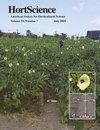Root System Reductions of Grafted ‘Valencia’ Orange Trees Are More Extensive Than Aboveground Reductions after Natural Infection with Candidatus Liberibacter Asiaticus
IF 1.5
3区 农林科学
Q2 HORTICULTURE
引用次数: 0
Abstract
Huanglongbing (HLB), which is associated with the phloem-limited bacteria Candidatus Liberibacter asiaticus (CLas), is a devastating disease that affects citrus trees worldwide. Because of the pervasiveness of the bacteria and psyllid vector, the disease is considered endemic in Florida. Although the effects of CLas on tree growth and physiology have been investigated for decades, most studies compared infected and noninfected trees under greenhouse conditions. This study used newly planted field-grown ‘Valencia’ sweet orange (Citrus sinensis) trees on two different rootstocks to monitor the distribution and accumulation of CLas in aboveground and belowground tissues following natural psyllid colonization and assess tree physiological responses and biomass reductions under HLB-endemic conditions. Trees were transplanted into the field with individual protective covers (IPCs), which are used to exclude psyllids and prevent infection. Openings were cut in the IPCs of half of the trees; to promote infection, these IPCs were temporarily removed during the main vegetative flushing period when psyllid populations were high. All trees that were exposed to psyllids became infected and displayed the symptoms typically associated with HLB. Throughout the study, higher levels of CLas were detected in the leaves compared with those in the fibrous roots. Trees that were not exposed to psyllids remained noninfected and healthy. After 18 months, a subset of trees was excavated to assess biomass differences between infected and noninfected trees. Infected trees had root system reductions of 37% and shoot system reductions of 20%, thereby significantly reducing the belowground-to-aboveground biomass ratio. Fibrous root loss was 49% and more severe than the loss of the rest of the root tissue. This study is the first to demonstrate the full extent of damage caused by CLas infection under natural HLB-endemic conditions. The results confirm previous observations that suggested fibrous root loss as one of the major consequences of infection and colonization with CLas. They also reinforce the benefits of using IPCs to prevent infection of young citrus trees during the first years of growth in the field.嫁接的 "瓦伦西亚 "橙树在受到亚洲自由杆菌自然感染后,根系减少的程度比地上部分减少的程度更严重
黄龙病(HLB)与韧皮部局限性细菌 "亚洲自由杆菌"(CLas)有关,是一种影响全球柑橘树的毁灭性疾病。由于这种细菌和虫媒的普遍性,该病被认为是佛罗里达州的地方病。尽管几十年来人们一直在研究 CLas 对柑橘树生长和生理的影响,但大多数研究都是在温室条件下比较受感染和未感染的柑橘树。本研究使用两种不同砧木上新种植的田间 "瓦伦西亚 "甜橙(Citrus sinensis)树,以监测在银粉虱自然定殖后 CLas 在地上和地下组织中的分布和积累情况,并评估 HLB 流行条件下树木的生理反应和生物量减少情况。树木被移植到田间时,会带有独立的保护罩(IPC),用于排除牛皮蝇并防止感染。在一半树木的 IPC 上开了个口子;为了促进感染,在主要植株冲洗期,也就是牛皮蝇数量较多的时候,这些 IPC 被暂时移除。所有接触过木虱的树木都受到了感染,并表现出与 HLB 相关的典型症状。在整个研究过程中,叶片中检测到的 CLas 含量高于须根中的含量。没有接触到牛皮蝉的树木仍然没有受到感染,而且很健康。18 个月后,对一部分树木进行了挖掘,以评估受感染树木和未受感染树木之间的生物量差异。受感染树木的根系减少了 37%,芽系减少了 20%,从而显著降低了地下与地上生物量的比率。纤维根损失了 49%,比其他根组织的损失更为严重。这项研究首次证明了在 HLB 自然流行条件下 CLas 感染所造成的全面损害。研究结果证实了之前的观察结果,即纤维根损失是 CLas 感染和定殖的主要后果之一。这些结果还进一步证实了在柑橘幼树在田间生长的最初几年使用 IPC 预防感染的益处。
本文章由计算机程序翻译,如有差异,请以英文原文为准。
求助全文
约1分钟内获得全文
求助全文
来源期刊

Hortscience
农林科学-园艺
CiteScore
3.00
自引率
10.50%
发文量
224
审稿时长
3 months
期刊介绍:
HortScience publishes horticultural information of interest to a broad array of horticulturists. Its goals are to apprise horticultural scientists and others interested in horticulture of scientific and industry developments and of significant research, education, or extension findings or methods.
 求助内容:
求助内容: 应助结果提醒方式:
应助结果提醒方式:


